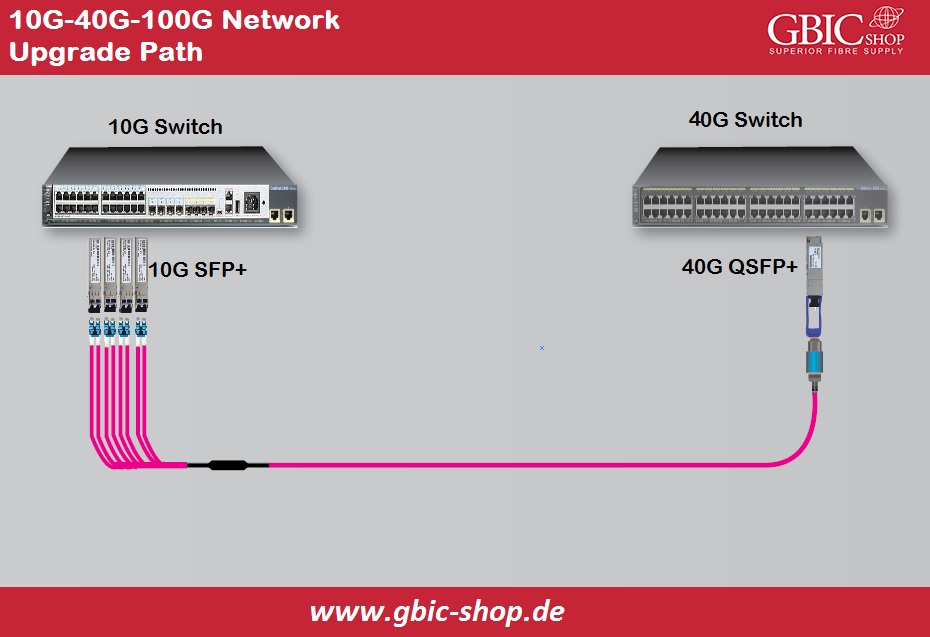Driven by the bandwidth requirements of public and private cloud transmission and database service providers, 100 Gigabit experienced a remarkable boom, making network evolution an important and necessary trend. This article compares the evolution paths of 10 Gigabit 25 Gigabit 100 Gigabit and 10 Gigabit 40 Gigabit 100 Gigabit networks to help customers make network upgrade decisions.
NETZAUSBAU VON 10G-40G-100G:
Although 100 Gigabit is the subsequent major discovery in speeds for large databases, 40 Gigabit can still endure and survive in the industry. Popular industries with tier 2 and 3 data centers that have low density requirements and tight budgets can efficiently leverage the 40 Gigabit fabric with 10 Gigabit service speeds as an existing building block.
EINE ANALYSE DES 40G-NETZES: WÄCHST WÄCHST 40GbE?
40GbE was introduced in 2008 and adopted in 2010. It enables the transmission of Ethernet on QSFP+ at 40 gigabits per second. For medium and small enterprises, 40 Gigabit switches are used as core switches. Data centers, on the other hand, act as leaf switches. Although 40 Gigabit has been in use in the industry for some time, its development is encountering problems. Unlike 40 Gigabit, 100 Gigabit has an excellent technical solution, standard research and progress in the industrial chain.
MIGRATIONSPFAD DES 10G-40G-100G-NETZES:.
However, considering the optical transceiver modules we use, a migration path can be very costly. For the 10G-40G-100G migration path, we will use a 10 Gigabit cabling system. We have designed 40-Gigabit QSFP+ modules with 4 aligned 10-Gigabit channels and 100-Gigabit QSFP+ modules for an aligned channel standard of 10 x 10 Gigabit. Since the base of a channel rate is 10 Gigabit, the migration path from 10G-40G-100G requires other fibers, resulting in more complex cabling and higher prices.
On the other hand, when we use QSFP modules in long-distance communication, such as QSFP+ LLR4 fiber module, four 10-gigabit channels are combined into one fiber link via WDM (wavelength division multiplexing). For this reason, the price of QSFP fiber modules is high, especially for 40-gigabit fiber with a long communication range like QSFP+ ER4. This also increases the cost of a 100 Gigabit network upgrade.

MIGRATION VON 10G-25G-100G-NETZEN:.
Data centers are expanding at an extraordinary pace, increasing the need for greater bandwidth between switches and servers. The Ethernet industry and the networking industry are migrating from 10 Gigabit to 25 Gigabit, which is of particular interest for server-to-TOR connections in terms of density, price and performance.
EINE ANALYSE DES 25G-NETZES: WÄCHST WÄCHST 25GbE?
Companies such as Microsoft, Google, Mellanox, Arista, etc. proposed and adopted 25G Ethernet for networking TOR servers in 2014. We often use 25 Gigabit network switches to connect end devices and servers, which makes connection speeds faster than 10 Gigabit without increasing cable connections. As we move forward with the most successful and fastest network bandwidth evolution path, no configuration changes can reduce costs and power consumption.
MIGRATIONSPFAD DES 10G-25G-100G-NETZES:.
The speed of a single 25 Gigabit channel corresponds to 2.5 times the communication capacity of 10 Gigabit. In contrast, in a 100 Gigabit network, we only need four channels of 24 Gigabit fiber modules to achieve the 4 x 25 Gigabyte mode. With the evolution of the Ethernet industry and the establishment of a path to excessive network speeds such as 200 Gigabit and 400 Gigabit, the 25G-100G upgrade has emerged as a necessary roadmap for the data centers of the coming era and will significantly protect fiber links. However, this path will remove the current 10 Gigabit equipment in the facility. This movement has increased total system revenue by 2.5 times with little additional cost, which is why 100 Gigabit switches and 25 Gigabit servers have become popular in large data centers, moderately replacing the previous 40 Gigabit switches and 10 Gigabit servers.
/a%20necessary%20roadmap%20for%20coming%20times%E2%80%99%20data%20centers%20(4).jpg)
A COMPARISON OF NETWORK MIGRATION PATHS: WHY EXPAND 10G TO 20G?
Prior to the release of 25G Ethernet details, we primarily adopted an upgrade path from 10G-40G as an alternative for service providers, enterprises, and scalable data centers beyond 10G Ethernet. However, with the evolution of 25G Ethernet, the 25G-100G upgrade path has become more important. How can we differentiate between the upgrade path of 25 Gigabit and 40 Gigabit? Can I upgrade 10 Gigabit to 25 Gigabit?
/a%20necessary%20roadmap%20for%20coming%20times%E2%80%99%20data%20centers%20(2).jpg)
We can see some obvious advantages in the 10G-25G-100G migration process compared to the 10G-40G-100G migration path.
• COST-EFFECTIVE: The 25G-100G migration path can save operational expenditure (OPEX) and capital expenditure (CAPEX) through backward adaptability for investment security and perfect migrations with constant reuse of current cabling architecture without expensive and complicated changes.
• EFFICIENT: The single-track 25 Gigabit SERDES technology we use for 100 GbE to 25 Gigabit links is the same as for 40 Gigabit to 10 Gigabit links. However, performance increases by 2.5 times, which significantly reduces power consumption and the price per gigabit.
• EXCESSIVE DENSITY: 25GbE offers higher system and port density than the equivalent 40 Gigabit solution. The 25G-100G migration path offers a lower price per unit of bandwidth than the 40G-100G upgrade path by fully utilizing cabinet capacity.
Conclusion:
When choosing a migration path, think about your future expansion and the scale of your business. For growing network needs and ongoing benefits, upgrading from 25 Gigabit to 100 Gigabit is the ideal path. However, it is unnecessary to aim for a 10G-25G-100G migration path when a 40 Gigabit network is deployed and the existing network meets your needs. By providing additional bandwidth and excessive port density while decreasing price and power consumption, the 10G-25G-100G migration path naturally eliminates the need for standard 10G-40G-100G connections to improve data center efficiency, setting the stage for further upgrades to 200 Gigabit and 400 Gigabit.
 English
English
 Deutsch
Deutsch
 Espaniol
Espaniol










